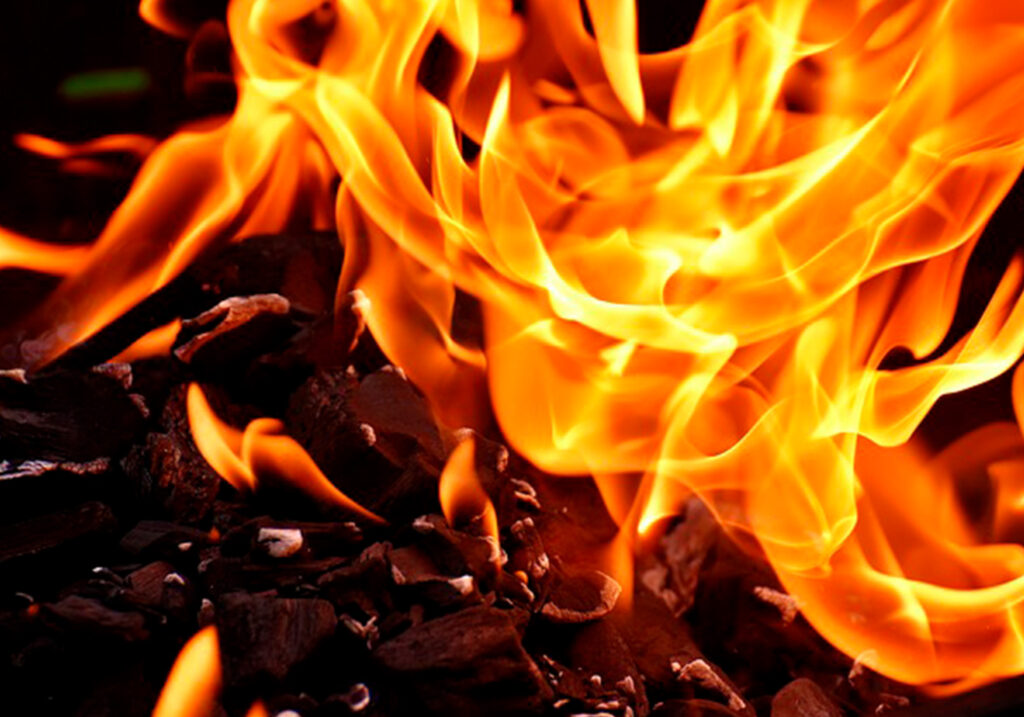With the wildfires that happened recently in January, it is obvious that many people are concerned about their own safety. They watched in horror as million-dollar homes were turned into ashes.
Everyone is worried, and we have questions from a lot of people who own metal barns and are asking us for some tips on how to prevent fires.
Metal barns are widely used for agricultural, storage, and equestrian purposes due to their durability and cost-effectiveness. While metal structures are generally more fire-resistant than wood, they are not entirely immune to fire hazards. Implementing fire prevention strategies is essential to protect livestock, equipment, feed, and the structural integrity of your barn. This article outlines effective fire prevention tips to safeguard your metal barn from potential fire risks.
1. Install Fire Detection and Alarm Systems
Early detection of fire is crucial in minimizing damage and ensuring safety. Installing smoke detectors, heat detectors, and fire alarms in strategic areas of the barn can provide an early warning system. Modern alarm systems can be connected to your smartphone or local fire department for immediate alerts. Regularly test these devices to ensure they are functioning correctly and replace batteries as needed.
In addition to standard smoke and heat detectors, consider integrating smart fire detection systems that can monitor temperature fluctuations and air quality. These systems can provide more precise alerts and allow for quicker responses. Installing alarms near high-risk areas, such as storage rooms and electrical panels, further enhances safety by ensuring immediate detection of potential hazards.
2. Maintain Electrical Safety
Faulty wiring and electrical equipment are common causes of barn fires. Have a licensed electrician inspect and maintain all electrical systems regularly. Use weatherproof and rodent-proof wiring conduits to prevent damage. Avoid overloading circuits and unplug non-essential electrical devices when not in use. Install surge protectors for sensitive equipment and keep all electrical panels clear of obstructions.
Regular maintenance should include checking for frayed wires, outdated panels, and improperly grounded circuits. Installing ground fault circuit interrupters (GFCIs) in damp or high-risk areas can prevent electrical fires by shutting off power when irregularities occur. Additionally, keeping electrical systems up to code ensures that your barn meets safety standards and minimizes the risk of electrical hazards.
3. Proper Storage of Flammable Materials
Store flammable materials such as gasoline, oil, pesticides, and fertilizers in a separate, well-ventilated storage building away from the main barn. Use approved safety containers for fuel storage and keep them tightly sealed. Label hazardous materials clearly and ensure they are kept out of reach of children and animals.
Implementing spill containment measures, such as secondary containment trays, can further mitigate risks associated with flammable liquids. Regularly inspect storage areas for leaks and ensure that ventilation systems are functioning properly. Providing clear signage and safety data sheets for hazardous materials also educates workers and visitors on proper handling and emergency procedures.
4. Implement a No-Smoking Policy
Smoking in or around the barn significantly increases the risk of fire. Enforce a strict no-smoking policy and post visible signs to remind workers and visitors. Designate a smoking area far from the barn, complete with proper receptacles for cigarette disposal to prevent accidental fires.
Additionally, educate employees and visitors about the risks associated with smoking near combustible materials. Incorporate the no-smoking policy into employee handbooks and training sessions. Regular monitoring and enforcement of this policy ensure that everyone on the property adheres to safety protocols.
5. Maintain Cleanliness and Order
Clutter and dust can contribute to fire hazards. Regularly clean the barn to remove dust, cobwebs, and combustible debris. Keep hay, straw, and feed stored in dry, well-ventilated areas to prevent spontaneous combustion. Organize tools and equipment to ensure clear pathways and minimize fire spread.
Implementing a cleaning schedule can help maintain a tidy and safe environment. Use metal storage bins for combustible materials and ensure that exits and escape routes are free from obstructions. Encouraging regular housekeeping among staff reinforces the importance of maintaining a fire-safe space.
6. Install Fire Extinguishers
Equip your barn with fire extinguishers suitable for different types of fires, such as Class A (ordinary combustibles), Class B (flammable liquids), and Class C (electrical fires). Place extinguishers in easily accessible locations and ensure all staff and family members are trained in their proper use. Perform regular maintenance checks to ensure they are fully charged and functional.
Conduct routine fire safety training that includes hands-on demonstrations of how to operate extinguishers. Place signage indicating extinguisher locations and make sure they are not blocked by equipment or clutter. Establishing a clear inspection schedule helps maintain readiness in case of an emergency.
7. Use Fire-Resistant Building Materials
Incorporate fire-resistant materials in your barn’s construction and maintenance. Metal roofing and siding offer better fire protection than traditional wood. Use fire-rated doors and insulation materials, and seal any gaps or openings where embers could enter. Consider installing fire-resistant barriers between sections of the barn to slow fire spread.
Opting for non-combustible insulation, such as mineral wool, can provide additional fire resistance. Upgrading to fire-rated windows and using intumescent paints on wooden surfaces can further enhance the barn’s ability to withstand heat and flames. Regularly inspecting these materials ensures their continued effectiveness.
8. Control Vegetation and Debris
Clear brush, tall grass, and other flammable vegetation from around the barn’s perimeter to create a defensible space. Maintain a buffer zone of at least 30 feet by regularly mowing, trimming trees, and removing dead plants. Dispose of waste materials properly and avoid burning trash near the barn.
Consider installing gravel or fire-resistant landscaping around the barn to minimize vegetation growth. Regularly inspect gutters and roofs for accumulated leaves and debris, which can ignite easily. Implementing these measures helps reduce the risk of fire spreading to the barn during wildfires or dry seasons.
9. Maintain Equipment and Machinery
Regular maintenance of farm equipment and machinery is essential to prevent fire hazards. Clean equipment regularly to remove grease, oil, and debris buildup. Store machinery with fuel tanks in well-ventilated, designated areas. Turn off engines and allow them to cool before refueling.
Perform routine inspections to identify leaks, worn belts, and other fire hazards. Keep fire extinguishers near fueling stations and high-risk machinery. Adhering to manufacturer maintenance schedules ensures equipment operates safely and efficiently.
10. Establish an Emergency Plan
Develop and implement a comprehensive fire emergency plan for your barn. Include evacuation procedures for people and animals, emergency contact information, and designated meeting points. Train all workers, family members, and frequent visitors on fire response protocols. Conduct regular fire drills to ensure everyone knows how to react in an emergency.
Ensure the emergency plan includes accessible maps showing escape routes and fire extinguisher locations. Keep first aid kits and emergency supplies readily available. Reviewing and updating the plan regularly helps maintain preparedness and reduces confusion during a crisis.
11. Install Lightning Protection Systems
Lightning strikes are a common cause of barn fires. Install a lightning rod system to safely direct electrical surges into the ground. Ensure the system is properly grounded and maintained to minimize the risk of lightning-induced fires.
Regular inspections and maintenance of the lightning protection system are crucial for its effectiveness. Installing surge protectors on electrical systems can further safeguard against lightning-related damage. These measures collectively reduce the likelihood of fires resulting from electrical surges.
12. Separate Living Quarters from Barn Space
If your barn includes living quarters or office space, ensure these areas are well-separated from storage and animal areas. Use fire-rated walls and doors to divide spaces and install separate electrical circuits to reduce fire risks. Consider installing additional fire alarms and extinguishers in living quarters.
Implementing smoke barriers and compartmentalizing the building can slow fire spread and provide safer evacuation routes. Regular safety checks of living quarters ensure that fire prevention measures are up to date, further protecting occupants and property.
13. Monitor Temperature and Humidity
High temperatures and humidity levels can increase the risk of spontaneous combustion, especially in hay storage areas. Use temperature and humidity monitors to maintain safe storage conditions. Store hay in smaller stacks and allow proper airflow to prevent heat buildup.
14. Restrict Use of Open Flames
Avoid using open flames, such as candles, torches, or welding equipment, inside or near the barn. If welding or cutting is necessary, follow strict safety protocols, including clearing the area of flammable materials and having fire extinguishers nearby. Supervise any use of open flames and ensure they are fully extinguished after use.
15. Regular Inspections and Maintenance
Schedule routine inspections of the barn and surrounding property to identify and address potential fire hazards. Check for damaged wiring, faulty equipment, and accumulation of combustible materials. Promptly repair any structural damage that could contribute to fire risk.
Conclusion
With these tips, you can prevent fires in your metal barn. Invest time and resources into fire prevention to protect your property and livestock. Prioritizing fire safety in your metal barn is a crucial step toward long-term security and peace of mind.

